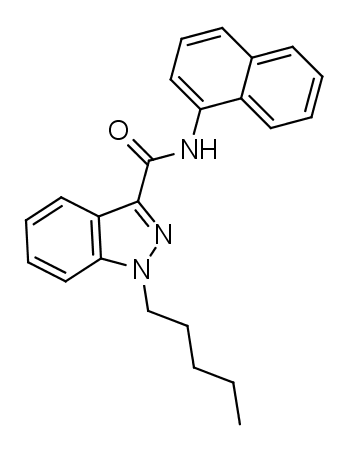Summary
MN-18, an indazole-based synthetic cannabinoid, acts as an agonist for cannabinoid receptors, featuring Ki values of 45.72 nM at CB1 and 11.098 nM at CB2, alongside EC50 values of 2.028 nM at CB1 and 1.233 nM at CB2, highlighting its affinity for these receptors. This compound has been available online under the guise of a designer drug, a term often applied to substances created to mimic the effects of controlled drugs. Notably, MN-18 shares its indazole core with NNE1. There is suspicion that akin to the related compound APINACA, the metabolic breakdown of MN-18’s amide group could potentially release 1-naphthylamine, a recognized carcinogen. Literature has addressed the metabolism of MN-18.
| Identifiers | |
|---|---|
| IUPAC name | |
| CAS Number | 1391484-80-2 |
|---|---|
| PubChem CID | 119058030 |
| ChemSpider | 29763729 |
| UNII | GP2N1PG5X2 |
| CompTox Dashboard (EPA) | DTXSID301010033 |
| Chemical and physical data | |
| Formula | C23H23N3O |
| Molar mass | 357.457 g·mol−1 |

Legal status
MN-18 was prohibited in Sweden, although the specific date of the ban is not provided. Additionally, on September 15, 2014, the Turkish government also took action to ban the sale of MN-18.
FAQ
- What is MN-18?
- MN-18 is a synthetic cannabinoid, a type of designer drug designed to mimic the effects of natural cannabinoids.
- What are the Ki and EC50 values associated with MN-18?
- MN-18 has Ki values of 45.72 nM at CB1 and 11.098 nM at CB2, along with EC50 values of 2.028 nM at CB1 and 1.233 nM at CB2. These values indicate its affinity for cannabinoid receptors.
- Has MN-18 been sold online as a designer drug?
- Yes, MN-18 has been available online under the classification of a designer drug, which refers to substances created to replicate the effects of controlled substances.
- What is the relationship between MN-18 and NNE1?
- MN-18 shares its indazole core with NNE1, which means they have a similar structural foundation.
- Is there concern about the metabolic breakdown of MN-18?
- Yes, there is suspicion that the metabolic hydrolysis of MN-18’s amide group may release 1-naphthylamine, a known carcinogen. This possibility raises concerns about its potential health risks.
- When was MN-18 banned in Sweden?
- Unfortunately, the specific date of the ban in Sweden is not provided.
- When did the Turkish government ban the sale of MN-18?
- The Turkish government took action to ban the sale of MN-18 on September 15, 2014.
- Is MN-18 legal in other countries?
- The legal status of MN-18 can vary from one country to another. It’s essential to check the specific regulations and laws in your region regarding this substance.
- What should I do if I have questions or concerns about MN-18?
- Suppose you have questions or concerns about MN-18, its legal status, or potential health risks. In that case, it is advisable to consult with relevant authorities, healthcare professionals, or addiction specialists for guidance and information.
References
- Gamage TF, Farquhar CE, Lefever TW, Marusich JA, Kevin RC, McGregor IS, et al. conducted a study in May 2018, characterizing the molecular and behavioral pharmacology of abused synthetic cannabinoids, including MMB- and MDMB-FUBINACA, MN-18, NNEI, CUMYL-PICA, and 5-Fluoro-CUMYL-PICA, shedding light on their effects and properties.
- “MN-18” information can be found on the Southern Association of Forensic Scientists’ website, although the original source has been archived since July 23, 2015, offering insights into this synthetic cannabinoid.
- In February 2015, Uchiyama N, Shimokawa Y, Kikura-Hanajiri R, Demizu Y, Goda Y, and Hakamatsuka T identified N-OH-EDMA and a cathinone derivative dimethoxy-α-PHP, both newly discovered in illegal products, contributing to the understanding of the evolving landscape of illicit substances.
- Diao X, Carlier J, Zhu M, and Huestis MA investigated the human hepatocyte metabolism of novel synthetic cannabinoids MN-18 and its 5-fluoro analog 5F-MN-18 in November 2017, providing insights into how these substances are processed in the human body.
- Kevin RC, Lefever TW, Snyder RW, Patel PR, Gamage TF, Fennell TR, et al. explored the kinetic and metabolic profiles of synthetic cannabinoids NNEI and MN-18 in their study published in January 2018, contributing to our understanding of the pharmacological aspects of these compounds.
- On May 28, 2014, “Cannabinoider föreslås bli klassificerade som hälsofarlig vara,” indicating that cannabinoids were proposed to be classified as health hazardous substances by Sweden’s Public Health Agency, reflecting evolving regulations and concerns regarding these compounds.
- The Turkish Drug Law List, published in Resmi Gazete on September 15, 2014, includes information about substances subject to legal restrictions, including MN-18, reflecting the international efforts to control and regulate synthetic cannabinoids.